 The
history of Architecture & Music
The
history of Architecture & Music

The Architecture
of Ancient Egypt
 The architecture of ancient Egypt
The architecture of ancient Egypt is mostly known for the tombs and temples,
built for the kings and gods of that civilization. The pyramids
is mostly known for the tombs and temples,
built for the kings and gods of that civilization. The pyramids are the best known of the Egyptian tombs. Destined for the use of the dead
kings after resurrection, they are huge and it is almost unbelievable that
such an ancient civilization, lacking any modern technology, could actually
build such astounding structures. They symbolize the rays of the sun and
are full of writing, based on small pictures, known as the hieroglyphics
are the best known of the Egyptian tombs. Destined for the use of the dead
kings after resurrection, they are huge and it is almost unbelievable that
such an ancient civilization, lacking any modern technology, could actually
build such astounding structures. They symbolize the rays of the sun and
are full of writing, based on small pictures, known as the hieroglyphics .
The Greeks and the Romans later adopted some of the Egyptians
architectural forms, such as the columns and capitals (the column tops).
.
The Greeks and the Romans later adopted some of the Egyptians
architectural forms, such as the columns and capitals (the column tops).
The Architecture
of Ancient Greece
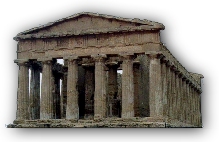 The ancient Greek
The ancient Greek temples were built in certain forms and proportions
that were meant to be pleasing to the gods. The three architectural
styles that were mainly in use are the Doric
temples were built in certain forms and proportions
that were meant to be pleasing to the gods. The three architectural
styles that were mainly in use are the Doric ,
with it's rectangle abacus, The Ionic
,
with it's rectangle abacus, The Ionic ,
with the spiral scrolls and the Corinthian
,
with the spiral scrolls and the Corinthian ,
identified by capitals with the shape of Acanthus leaf. The last will be
adopted by the Romans.
,
identified by capitals with the shape of Acanthus leaf. The last will be
adopted by the Romans.

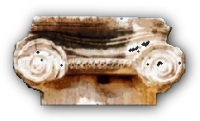
The Architecture
of Ancient Rome
 At
first, the Romans
At
first, the Romans made extensive use of the Greek architectural characteristics, but from
the first century AD, they concentrated on the interiors of buildings,
in contrast to the Greeks emphasis on the exterior. By using arches, domes
and decorative columns inside buildings and decorating the internal walls,
Roman architecture remained influential for many centuries.
Roman Architecture was calm, just
like the Gregorian chant
made extensive use of the Greek architectural characteristics, but from
the first century AD, they concentrated on the interiors of buildings,
in contrast to the Greeks emphasis on the exterior. By using arches, domes
and decorative columns inside buildings and decorating the internal walls,
Roman architecture remained influential for many centuries.
Roman Architecture was calm, just
like the Gregorian chant .
Semi-circular arches, leaning against giant-size cylindrical columns in
the spirit of Romanesque style. Small, dark spaces, and small windows.
The Gregorian chant is serene, too, and emphasizes the religious relaxation
and believer's acceptance of his or her being completely in the hands of
the All-Mighty.
.
Semi-circular arches, leaning against giant-size cylindrical columns in
the spirit of Romanesque style. Small, dark spaces, and small windows.
The Gregorian chant is serene, too, and emphasizes the religious relaxation
and believer's acceptance of his or her being completely in the hands of
the All-Mighty.
The Architecture
of the Middle Ages - Romanesque
 Many
churches were built in Europe during the Middle Ages, with high and solid
stone vaults supported by massive piers and columns. The
Romanesque architecture adopted, in the 10th century, many early Christian
and Roman ideas, such as cross-shaped ground
plans
Many
churches were built in Europe during the Middle Ages, with high and solid
stone vaults supported by massive piers and columns. The
Romanesque architecture adopted, in the 10th century, many early Christian
and Roman ideas, such as cross-shaped ground
plans .
Many kinds of constructions were built, including castles
with rectangular keeps, and houses with pitched roofs, like the medieval
London
.
Many kinds of constructions were built, including castles
with rectangular keeps, and houses with pitched roofs, like the medieval
London bridge.
bridge.
The Gothic
Architecture of the Middle Ages
 The
Gothic buildings with the ribbed vaults, stained-glass windows and pointed
arches, became popular in the 12th century (see the Notre
Dame de Paris) in France
The
Gothic buildings with the ribbed vaults, stained-glass windows and pointed
arches, became popular in the 12th century (see the Notre
Dame de Paris) in France and later in all Europe. Gothic designers
included ballflowers' embellishments and other decorated elements in the
English
and later in all Europe. Gothic designers
included ballflowers' embellishments and other decorated elements in the
English decorative style of the 14th century. The English perpendicular style of
the 15th century tended to use the hammer-beam roof and emphasized the
horizontal and vertical elements in their structures.
The new construction techniques
of the Gothic style, such as the pointed arch, and the supporting "flying
buttresses", both enabled taller, more impressive constructions to
be built. In this style, space is symmetrical and more complex than it
used to be, underlining order and rhythm, just like in the complicated,
rhythmical, polyphonic music composed during this era, as is particularly
manifested in the organum
decorative style of the 14th century. The English perpendicular style of
the 15th century tended to use the hammer-beam roof and emphasized the
horizontal and vertical elements in their structures.
The new construction techniques
of the Gothic style, such as the pointed arch, and the supporting "flying
buttresses", both enabled taller, more impressive constructions to
be built. In this style, space is symmetrical and more complex than it
used to be, underlining order and rhythm, just like in the complicated,
rhythmical, polyphonic music composed during this era, as is particularly
manifested in the organum .
.
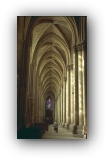
The Architecture
of the Renaissance
Originated in Italy ,
the Renaissance in architecture was marked by a return to the proportions
of ancient Roman buildings and the return to the classical forms. Renaissance
architects were interested in returning to the simplicity of the Roman
,
the Renaissance in architecture was marked by a return to the proportions
of ancient Roman buildings and the return to the classical forms. Renaissance
architects were interested in returning to the simplicity of the Roman and Greek
and Greek styles. They adopted the symmetry and the total harmony of the ancient
design as a reaction to the Gothic over-embellished style. Later architects
distorted the classical forms in a style called Mannerism
styles. They adopted the symmetry and the total harmony of the ancient
design as a reaction to the Gothic over-embellished style. Later architects
distorted the classical forms in a style called Mannerism .
.
The Renaissance, having revived Roman
styles and adapted them to up-date construction techniques, also found
its expression in music, giving birth to harmony ,
restoring manís place in the center of things (folk singers called troubadours
,
restoring manís place in the center of things (folk singers called troubadours performed all over Europe, choirs
performed all over Europe, choirs and unaccompanied singers perform art music, and music becomes an independent
art).
and unaccompanied singers perform art music, and music becomes an independent
art).
The Architecture
of the Baroque
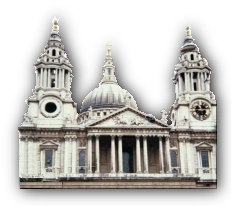 The
Baroque architecture evolved in Rome
The
Baroque architecture evolved in Rome and later spread to Germany
and later spread to Germany and Spain
and Spain ,
where it is characterized by ostentatious decoration and curved outlines.
In other countries, it was adopted with adaptations. In England
,
where it is characterized by ostentatious decoration and curved outlines.
In other countries, it was adopted with adaptations. In England ,
architects such as Wren
,
architects such as Wren used baroque features with great restraint.
Baroque architecture, using plane
lines with elaborated ornaments, for the purpose of building giant churches
and extravagant palaces, reminds one of the magnificence of Baroque polyphony
used baroque features with great restraint.
Baroque architecture, using plane
lines with elaborated ornaments, for the purpose of building giant churches
and extravagant palaces, reminds one of the magnificence of Baroque polyphony ,
well demostrated in the work of J.S. Bach
,
well demostrated in the work of J.S. Bach ,
taking simple tunes, making them into astonishingly elaborated, complex
polyphonic pieces.
,
taking simple tunes, making them into astonishingly elaborated, complex
polyphonic pieces.
The
Architecture of the Rococo and Classical period
The pre-classical Rococo ,
a French
,
a French early 18th century lavish form, was a reaction to the seriousness,
rigidity, and formalism of the Baroque.
A counterpart to this movement
in architecture can be found in the Rococo
music, with its refined ornamentation, and
in the light and elegant Galant music,
with its pleasing tunefulness and prettiness. These styles replaced the
Baroque's serious polyphony
early 18th century lavish form, was a reaction to the seriousness,
rigidity, and formalism of the Baroque.
A counterpart to this movement
in architecture can be found in the Rococo
music, with its refined ornamentation, and
in the light and elegant Galant music,
with its pleasing tunefulness and prettiness. These styles replaced the
Baroque's serious polyphony with a melody and harmony and heavy ornamentation
with a melody and harmony and heavy ornamentation .
.
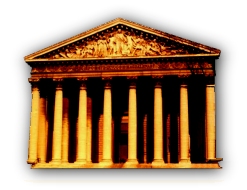 On
the other side came Neoclassicism
On
the other side came Neoclassicism which developed in Northern Europe
during the 17th century. Slightly ahead of its time, it was a reaction
to the Baroque's excess. The Madeleine Church
in Paris is a good example of this restrained
design.
Just like the buildings of that
period, Classical music is characterized by a structural clarity. With
their clearly articulated forms, contrasting themes and changing moods
in very close succession, Classical pieces are built as temples of enlightenment.
which developed in Northern Europe
during the 17th century. Slightly ahead of its time, it was a reaction
to the Baroque's excess. The Madeleine Church
in Paris is a good example of this restrained
design.
Just like the buildings of that
period, Classical music is characterized by a structural clarity. With
their clearly articulated forms, contrasting themes and changing moods
in very close succession, Classical pieces are built as temples of enlightenment.
The Architecture
of the 19th century
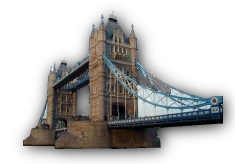 In
the 19th century, new materials such as steel and iron became alternatives
to wood (for the frames of buildings) and the diversity of styles became
unprecedented, from the industrialized iron buildings
In
the 19th century, new materials such as steel and iron became alternatives
to wood (for the frames of buildings) and the diversity of styles became
unprecedented, from the industrialized iron buildings to the Neo-Greek
to the Neo-Greek ,
Neo-Gothic
,
Neo-Gothic (as in the Tower Bridge in London
(as in the Tower Bridge in London )
and other forms of architecture, which tried to revive forms of the past
civilizations.
)
and other forms of architecture, which tried to revive forms of the past
civilizations.
The musical equivalent for the 19th
century neo-trends lies with the neo-classicist composers such as Brahms and Schumann
and Schumann ,
who incorporated elements from the distant and near past in their work,
and opposed the impulsiveness and over-emotionality of Romantic
,
who incorporated elements from the distant and near past in their work,
and opposed the impulsiveness and over-emotionality of Romantic art.
art.
The Architecture
of the 20th century
 The
new buildings made of steel-and-glass became very popular in the 20th century
and these materials allowed architects to design the modern skyscrapers.
Since the completion of the Empire State Building
The
new buildings made of steel-and-glass became very popular in the 20th century
and these materials allowed architects to design the modern skyscrapers.
Since the completion of the Empire State Building in 1931, with its 102 storeys, many skyscrapers have been built all over
the world, achieving world records in their heights.
Many other architectural styles were developed in the
20th century, but just like the music and art of the modern period, and
in contrast to the styles of the 19th century, they were all new and original
styles with almost no links to the past. Most architects tried to break
the rules, use new materials and offer completely new solutions to old
needs.
The Bauhaus
in 1931, with its 102 storeys, many skyscrapers have been built all over
the world, achieving world records in their heights.
Many other architectural styles were developed in the
20th century, but just like the music and art of the modern period, and
in contrast to the styles of the 19th century, they were all new and original
styles with almost no links to the past. Most architects tried to break
the rules, use new materials and offer completely new solutions to old
needs.
The Bauhaus ,
a school of architecture and design, founded in Weimar
in 1919 by Walter gropius and became central
in all Europe. This style fostered the idea
of the artist as craftsman. Bauhaus artists believed in a close study of
the nature of materials and a strict economy of means. The style was geometric,
severe and impersonal.
The emigration of Bauhaus architects and artists caused
by Nazism ensured the international spread of Bauhaus ideas to one of the
main trends in the modern architecture, from the 1950s and until today
- the functionalism
,
a school of architecture and design, founded in Weimar
in 1919 by Walter gropius and became central
in all Europe. This style fostered the idea
of the artist as craftsman. Bauhaus artists believed in a close study of
the nature of materials and a strict economy of means. The style was geometric,
severe and impersonal.
The emigration of Bauhaus architects and artists caused
by Nazism ensured the international spread of Bauhaus ideas to one of the
main trends in the modern architecture, from the 1950s and until today
- the functionalism .
This school argues that the design of a building has to reflect its function.
Many such buildings were built for banks, big firms etc.
.
This school argues that the design of a building has to reflect its function.
Many such buildings were built for banks, big firms etc.
At the same time, German composers, such as Paul Hindemith
composers, such as Paul Hindemith and Kurt Weill
and Kurt Weill represented the call for "Gebrauchsmusik"
represented the call for "Gebrauchsmusik" - a functional music. They believed in composing for the sake of society
and serving its needs.
- a functional music. They believed in composing for the sake of society
and serving its needs.
Towards the end of the century, other architects rejected
functionalism for the post-modernism school, which revived historical styles with new materials and techniques.
school, which revived historical styles with new materials and techniques.
Just as the world of music, that
has undergone severe twists and turns such as atonality ,
minimalism
,
minimalism ,
Dodecaphonic music
,
Dodecaphonic music ,
aleatory music
,
aleatory music and electronic music
and electronic music ,
the prevailing trend in 20th century architecture is one of great diversity
in building styles, new methods and materials, a total disintegration of
values that has dominated for centuries and millenniums, and on the other
hand, attempts to restore the very same values in some kind of a new form,
with cautious clinging to the magic of the past.
,
the prevailing trend in 20th century architecture is one of great diversity
in building styles, new methods and materials, a total disintegration of
values that has dominated for centuries and millenniums, and on the other
hand, attempts to restore the very same values in some kind of a new form,
with cautious clinging to the magic of the past.


MusixCool©
By Nadav Dafni




 At
first, the Romans
At
first, the Romans Many
churches were built in Europe during the Middle Ages, with high and solid
stone vaults supported by massive piers and columns. The
Romanesque architecture adopted, in the 10th century, many early Christian
and Roman ideas, such as cross-shaped ground
plans
Many
churches were built in Europe during the Middle Ages, with high and solid
stone vaults supported by massive piers and columns. The
Romanesque architecture adopted, in the 10th century, many early Christian
and Roman ideas, such as cross-shaped ground
plans The
Gothic buildings with the ribbed vaults, stained-glass windows and pointed
arches, became popular in the 12th century (see the Notre
Dame de Paris) in France
The
Gothic buildings with the ribbed vaults, stained-glass windows and pointed
arches, became popular in the 12th century (see the Notre
Dame de Paris) in France
 The
Baroque architecture evolved in Rome
The
Baroque architecture evolved in Rome On
the other side came Neoclassicism
On
the other side came Neoclassicism In
the 19th century, new materials such as steel and iron became alternatives
to wood (for the frames of buildings) and the diversity of styles became
unprecedented, from the industrialized iron buildings
In
the 19th century, new materials such as steel and iron became alternatives
to wood (for the frames of buildings) and the diversity of styles became
unprecedented, from the industrialized iron buildings The
new buildings made of steel-and-glass became very popular in the 20th century
and these materials allowed architects to design the modern skyscrapers.
Since the completion of the Empire State Building
The
new buildings made of steel-and-glass became very popular in the 20th century
and these materials allowed architects to design the modern skyscrapers.
Since the completion of the Empire State Building
